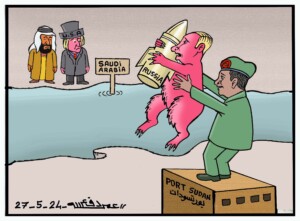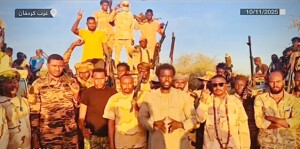Sudan’s resistance committees to unify political charters
The Sudanese resistance committees are currently working on the unification of the two political charters issued by resistance committees in the country.
The Revolutionary Charter for People’s Power (RCPP) , developed by the resistance committees in Wad Madani, capital of El Gezira, in mid-January, was signed by resistance committees in seven states. By the end of March, it was signed by resistance committees in eight more states.
 Logos of the two political charters issued by resistance committees earlier this year (Social media)
Logos of the two political charters issued by resistance committees earlier this year (Social media)
The Sudanese resistance committees are currently working on the unification of the two political charters issued by resistance committees in the country.
The Revolutionary Charter for People’s Power (RCPP) , developed by the resistance committees in Wad Madani, capital of El Gezira, in mid-January, was signed by resistance committees in seven states. By the end of March, it was signed by resistance committees in eight more states.
In end February, the Khartoum Resistance Committees Coordination released its final version of the Charter for the Establishment of the People’s Authority (CEPA) issued by the coordinating body of the resistance committees in Khartoum.
In the RCPP, “a clear focus on the democratization of decision making and wealth distribution can be found across all of its points. It includes a roadmap to form a government, starting with the selection of local councils in a process that would start immediately as part of the ongoing resistance against the coup,” Muzan Alneel writes in an analysis of the political situation in Sudan published on the site of the Tahrir Institute for Middle East Policy (TIMEP) in end April.
“In terms of political economy for example, the RCPP focuses on a national developmental project that aims to restructure Sudan’s rentier economy into a more industrial one, through a mixed economic policy guided by the public sector in collaboration with the private sector. The RCPP also clearly rejects the IMF’s structural adjustment programs and related austerity measures and argues for Sudan’s eligibility for preferential measures with regards to debt relief given the country’s extraordinary conditions.”
The CEPA “criticizes the political process for not addressing the economic, social, and cultural origins of Sudan’s current crisis, and highlights the “lack of sustainable developmental vision” for the country. These are all points it shares with the RCPP to some extent.
“However, the CEPA and the RCPP differ in terms of the tools proposed to implement these values,” Alneel states. “The CEPA is anchored around the concept of “uniting the political actors of the revolution” as a primary objective, not a tool. Accordingly, it envisions a path shaped by building consensus and finding compromises. This is clear for example in the issue of political economy where, despite prioritizing the “people’s rights to life,” the CEPA calls for “balancing the management of public debt and development requirements,” in a departure from the people-centered approach to development.
“The focus on development and provision of basic economic rights as the path to peace and stability in the country is a common feature of both charters. However, different arrangements of priorities have led to different tools and solutions being proposed, reflecting the general debate among various revolutionary committees on the ground.”
Alneel concludes his analysis by saying that “While the international community and regional powers continue to disregard the visions of the resistance committees, these visions are the ones discussed in the Sudanese streets. They are the ones distributed during protests and they have an incomparably higher chance of bringing stable peace to the country.”











 and then
and then